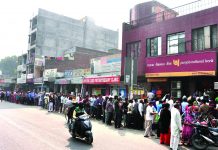
Plantar fasciitis, a condition that causes inflammation in the tissue connecting the heel to the toes, is becoming increasingly prevalent among India’s young working population. While it has traditionally been linked to older adults and athletes, a concerning rise in cases has been observed among young professionals.
Prolonged standing during daily commutes, combined with long hours spent on crowded metro trains and buses, is now a leading factor contributing to this painful condition.
Plantar fasciitis is increasingly affecting younger individuals in India, particularly those between the ages of 18 and 35. According to a 2023 study by the Indian Journal of Podiatry, around 12% of young adults in urban areas have reported symptoms similar to plantar fasciitis, with many attributing their foot pain to long hours of standing during their daily commutes in metros and buses.

Dr.Satyendra Singh , Bareilly, Uttar Pradesh, Member of doctube said that plantar fasciitis is a common cause of heel pain in young athletes, particularly those involved in running, dancing, or sports with frequent jumping. While specific data on increasing cases among youth is limited, the condition is recognized as an overuse injury in this demographic.
“Surgery is the choice of treatment Surgical Release of planter fascia from its attachments from healed bone Calcaneum,” he said.
He further said that prolonged standing or walking on hard surfaces, such as during long metro or bus rides, can contribute to plantar fasciitis.
While the condition is often linked to older adults, the high prevalence among younger Indians reflects the changing nature of work culture and urban commuting patterns. According to a survey conducted by the Urban Health Research Foundation in 2024, approximately 35% of urban Indian professionals aged 18 to 35 report experiencing significant foot pain after long metro or bus rides.
Alarmingly, 22% of them described their pain as consistent with the symptoms of plantar fasciitis, including sharp heel pain, especially in the morning or after long periods of standing.
“It’s a shooting pain in heels. One can’t walk in the morning and it gets worst as the day passes. Everytime you put your foot down you experience a never-ending pain and a struggle to walk,” a patient said.
India’s bustling urban centers, such as Delhi, Mumbai, Bengaluru, and Chennai, rely heavily on public transport systems. Metro trains, buses, and local trains are the lifeline of daily commuters, but the hours spent standing in overcrowded vehicles take a toll on foot health. According to data from the Ministry of Housing and Urban Affairs (2023), over 40 million people use public transportation daily in major Indian cities, with many standing for up to 45 minutes during peak hours.
Standing for prolonged periods, especially on hard surfaces, places significant stress on the plantar fascia, the thick band of tissue that runs across the bottom of the foot. This repetitive strain, coupled with the wear and tear from crowded conditions, is causing an increasing number of young commuters to develop plantar fasciitis.
“Early symptoms are stabbing pain in the heel, particularly in the morning or following extended periods of rest. If not treated, it results in chronic pain and mobility impairment. Prevention methods involve wearing appropriate shoes, stretching exercises, and a healthy weight. Young patients with persistent heel pain must obtain medical advice to avoid chronic complication,” Dr. Ramkinkar Jha, Chief and Unit Head – Orthopaedics (Unit III), Orthopaedic Surgery, Orthopaedics, Artemis Hospitals said.
Additionally, the sedentary nature of many office jobs contributes to this issue. With long hours spent sitting in front of computers, followed by the sudden strain of standing in crowded metro trains, young professionals are facing an increased risk of developing foot conditions.
The economic consequences of plantar fasciitis in India are not trivial. A 2023 report by The National Institute of Health and Family Welfare (NIHFW) estimated that musculoskeletal disorders, including plantar fasciitis, cost Indian businesses over Rs 10,000 crore annually in lost productivity due to absenteeism and healthcare costs. The rise in plantar fasciitis among young professionals is contributing to this burden, as many are forced to take sick leave or seek medical attention for chronic foot pain.
It is increasing among the young population. When you are traveling in metro and you are standing for a long time definitely there’s no activity and sometimes people stand on one leg it causes the pain, said Dr. Ajoy SM, Consultant, Dept of Orthopaedics, Foot & Ankle Specialist, Ramaiah Memorial Hospital.
“Prevention is got to do more with exercises that we need to do. Stretching of the back of the heel is necessary and we also need to stretch out the planter fascia itself, he added.
The condition is not just an economic issue—it also impacts the quality of life for many young Indians. As commuting is an integral part of daily life, persistent foot pain can significantly reduce mobility and work efficiency, affecting both personal and professional well-being.
Preventing plantar fasciitis requires a multi-faceted approach. Footwear that provides adequate arch support and cushioning is crucial for individuals who spend long hours standing. In addition, stretching exercises and foot care routines can help reduce the risk of developing the condition.
To address the growing issue of foot health, experts urge public awareness campaigns to educate commuters about the importance of proper footwear and the potential risks of long-standing commutes. Several healthcare providers are also recommending footrests or more frequent sitting opportunities during long metro or bus rides to reduce the strain on commuters’ feet.
Plantar fasciitis is rapidly becoming a significant health concern among India’s young, urban workforce. The combination of long hours of commuting, inadequate footwear, and sedentary lifestyles is contributing to an alarming rise in foot-related health problems. If current trends continue, India’s younger generation may face long-term mobility issues, resulting in both personal suffering and economic consequences.













